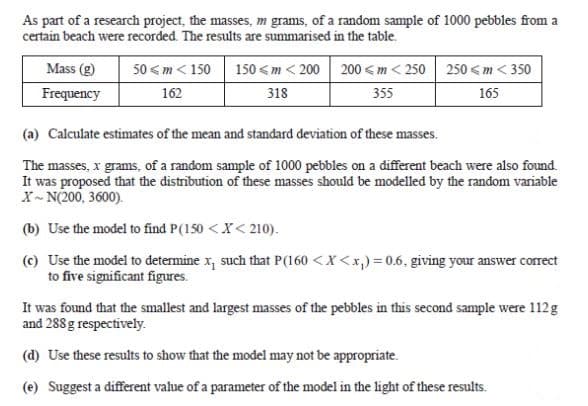As part of a research project, the masses, m grams, of a random sample of 1000 pebbles from a certain beach were recorded. The results are summarised in the table. Mass (g) 50 < m < 150 150
As part of a research project, the masses, m grams, of a random sample of 1000 pebbles from a certain beach were recorded. The results are summarised in the table. Mass (g) 50 < m < 150 150
Algebra: Structure And Method, Book 1
(REV)00th Edition
ISBN:9780395977224
Author:Richard G. Brown, Mary P. Dolciani, Robert H. Sorgenfrey, William L. Cole
Publisher:Richard G. Brown, Mary P. Dolciani, Robert H. Sorgenfrey, William L. Cole
Chapter7: Applying Fractions
Section7.1: Ratios
Problem 21WE
Related questions
Question

Transcribed Image Text:As part of a research project, the masses, m grams, of a random sample of 1000 pebbles from a
certain beach were recorded. The results are summarised in the table.
150 <m < 200 200 < m < 250 250 <m < 350
318
Mass (g)
50 < m < 150
Frequency
162
355
165
(a) Calculate estimates of the mean and standard deviation of these masses.
The masses, x grams, of a random sample of 1000 pebbles on a different beach were also found.
It was proposed that the distribution of these masses should be modelled by the random variable
X- N(200, 3600).
(b) Use the model to find P(150 <X< 210).
(c) Use the model to determine x, such that P(160 <X<x,) = 0.6. giving your answer correct
to five significant figures.
It was found that the smallest and largest masses of the pebbles in this second sample were 112g
and 288 g respectively.
(d) Use these results to show that the model may not be appropriate.
(e) Suggest a different value of a parameter of the model in the light of these results.
Expert Solution
This question has been solved!
Explore an expertly crafted, step-by-step solution for a thorough understanding of key concepts.
This is a popular solution!
Trending now
This is a popular solution!
Step by step
Solved in 4 steps

Knowledge Booster
Learn more about
Need a deep-dive on the concept behind this application? Look no further. Learn more about this topic, statistics and related others by exploring similar questions and additional content below.Recommended textbooks for you

Algebra: Structure And Method, Book 1
Algebra
ISBN:
9780395977224
Author:
Richard G. Brown, Mary P. Dolciani, Robert H. Sorgenfrey, William L. Cole
Publisher:
McDougal Littell

Holt Mcdougal Larson Pre-algebra: Student Edition…
Algebra
ISBN:
9780547587776
Author:
HOLT MCDOUGAL
Publisher:
HOLT MCDOUGAL

College Algebra (MindTap Course List)
Algebra
ISBN:
9781305652231
Author:
R. David Gustafson, Jeff Hughes
Publisher:
Cengage Learning

Algebra: Structure And Method, Book 1
Algebra
ISBN:
9780395977224
Author:
Richard G. Brown, Mary P. Dolciani, Robert H. Sorgenfrey, William L. Cole
Publisher:
McDougal Littell

Holt Mcdougal Larson Pre-algebra: Student Edition…
Algebra
ISBN:
9780547587776
Author:
HOLT MCDOUGAL
Publisher:
HOLT MCDOUGAL

College Algebra (MindTap Course List)
Algebra
ISBN:
9781305652231
Author:
R. David Gustafson, Jeff Hughes
Publisher:
Cengage Learning

Glencoe Algebra 1, Student Edition, 9780079039897…
Algebra
ISBN:
9780079039897
Author:
Carter
Publisher:
McGraw Hill